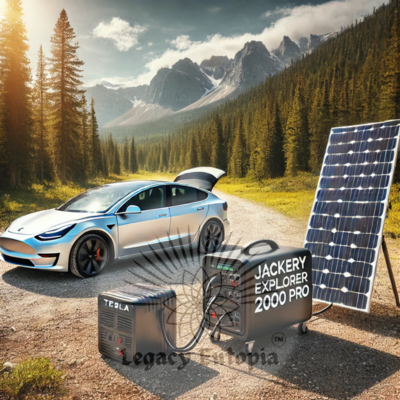Charging Your Tesla With Solar Panels
Use Solar Panels to Charge Your Tesla
Charging your Tesla with solar panels is a great way to stay sustainable and reduce energy costs. Here’s a guide on how to set up and charge your Tesla using solar energy effectively:

RELATED CATEGORY: Resources and Templates
Attaching Solar Panels to Roof Rack
Cheapest Place to Live in America
Use Solar Panels to Charge Your Tesla (you are here)
800 Watt Solar Power Vehicle Setup
Tesla Using a Portable Power Station
Tesla Solar Panel Installation
Tesla Traveling Across the United States
1. Determine Your Energy Requirements
- Tesla Battery Size: Tesla models have batteries ranging from about 50 kWh (Model 3 Standard Range) to 100 kWh (Model S/X Long Range).
- Daily Driving Needs: For example, driving 30 miles uses about 7-10 kWh.
- Solar Panel Output: A typical 400-watt solar panel produces around 1.6-2 kWh of energy per day, depending on sun exposure.
2. Solar Panels Needed to Charge a Tesla
- To generate 40 kWh (about half a full charge on a Model S) daily, you would need:
- 20-25 solar panels producing 400W each under optimal conditions.
- If you drive less, 8-12 panels could be enough to recharge your Tesla regularly for local commutes.
3. Installation Options
- Grid-Tied System: Most home systems are connected to the grid. You can charge your Tesla directly from the home charger, and any extra energy goes to the grid, which provides energy when solar is insufficient.
- Off-Grid System with Battery Storage:
- Includes solar panels, batteries (like Tesla Powerwall), and an inverter.
- This system allows you to store excess solar energy for use at night or during cloudy days.
4. Charging Options Using Solar Energy
- Tesla Wall Connector: Install a Wall Connector at home. It’s compatible with solar systems and can be used with grid-tied or off-grid setups.
- Mobile Connector: This is a portable option, which allows slower charging through standard outlets or 240V RV-style outlets, powered by solar batteries.
5. Optimize Solar Charging
- Charge When the Sun Shines: Set the Tesla to charge during the day when solar energy production is highest.
- Use Energy Management Systems: Some systems, like Tesla’s app or third-party solar management tools, allow you to schedule charging and monitor energy production and usage.
- Install a Powerwall or Backup Battery: A solar battery stores energy, so you can charge the Tesla overnight using stored solar energy.
6. Portable Solar Panels for On-the-Go Charging
While slower and more limited, you can use portable solar panels and battery kits when traveling off the grid:
- Jackery or EcoFlow Kits: These systems store energy from portable solar panels, which you can use to charge your Tesla through a standard outlet.
- Expect Limited Charging Speeds: Portable solutions offer low power, so they are best for emergencies rather than full charges.
7. Solar Incentives and Rebates
- Federal Tax Credit: You may be eligible for a federal solar tax credit (ITC) that covers up to 30% of your solar installation costs.
- State and Local Rebates: Some areas offer additional rebates or incentives for solar systems, making your Tesla solar setup more affordable.
By pairing your Tesla with a well-designed solar system, you can drive on sunshine and drastically reduce your carbon footprint while keeping long-term energy costs low. 🚗⚡
